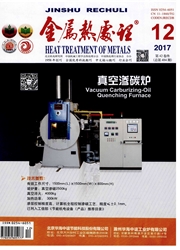

 中文摘要:
中文摘要:
采用高精度PLINT高温微动磨损试验机研究了690合金及其表面等离子体化学气相沉积(PCVD)制备TiN/TiSiN多层膜的高温微动磨损特性。结果表明,试验温度(25、200、300℃)下TiN/TiSiN多层膜XRD未检测出氧化物,TiN/TiSiN多层膜的硬度和临界载荷分别为2318 HV0.05、57 N。690合金在200℃时的摩擦因数、磨损体积均高于室温和300℃下的值。TiN/TiSiN多层膜的摩擦因数在200℃时最大,在室温时最低;TiN/TiSiN多层膜磨损体积受温度影响较小。相同试验条件下,TiN/TiSiN多层膜摩擦因数和磨损体积均低于690合金,TiN/TiSiN多层膜能有效减低基材的微动损伤。室温时,690合金磨损机制为磨粒磨损和剥层;200℃时为磨粒磨损、剥层和氧化磨损;300℃时为磨粒磨损和氧化磨损。试验温度下,TiN/TiSiN多层膜的磨损机制均为剥层。
 英文摘要:
英文摘要:
Fretting wear behavior of 690 alloy and TiN/TiSiN muhiplayer films deposited by Plasma Chemical Vapor Deposition(PCVD) on substrate at elevated temperature was investigated by using the hydraulic fretting test machine with a high precision. The results indicate that there are no oxides observed in TiN/TiSiN multiplayer films XRD patterns at test temperatures ( 25, 200, 300 ℃ ), the hardness and critical load of TiN/TiSiN multiplayer films are 2318 HV0.05 and 57 N respectively. The friction coefficient and wear volume of 690 alloy at 200 ℃ is higher than that at room temperature and 300 %. The friction coefficient evolution of TiN/TiSiN muhiplayer films reaches the maximum at 200 ℃ , and minimum at 25 ℃. The effect of temperature on wear volume for TiN/TiSiN multiplayer films is not remarkable. Under the same conditions, the friction coefficient and wear volume of TiN/TiSiN muhiplayer films are smaller than that of 690 alloy, and TiN/TiSiN multiplayer films can reduce the fretting damage of substrate effectively. The fretting mechanism of 690 alloy is abrasive wear and delamination at room temperature ; while the fretting mechanism is a combination of abrasive wear, oxidization wear and delamination at 200 ℃ ; and the fretting mechanism is abrasive and oxidization wear at 300 ℃. The fretting mechanism of TiN/TiSiN multiplayer films is delamination under different test temperature conditions.
 同期刊论文项目
同期刊论文项目
 同项目期刊论文
同项目期刊论文
 期刊信息
期刊信息
